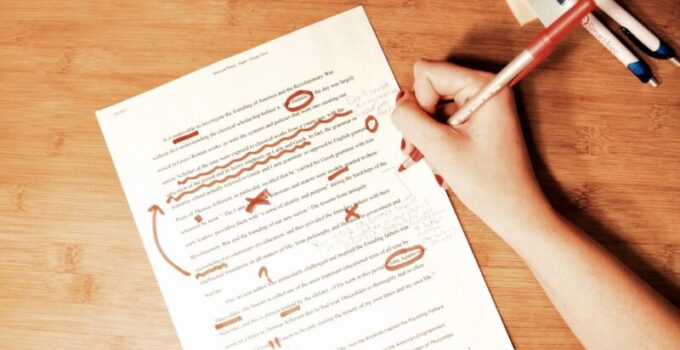The use of evidence is a key feature of academic writing. It allows a writer to make their argument compelling and develop strong support for their thesis statement. Without evidence, your argument is no more than an opinion. It’s unlikely to be persuasive or trustworthy.
You need to learn how to choose evidence, use an appropriate amount of it, and introduce it effectively. Continue reading the article to learn how to work with evidence and integrate it into your writing.
Page Contents
Sources of Evidence

Source: timeshighereducation.com
The choice of evidence depends on the subject and the purpose of your assignment. When students aren’t sure what type of data they need for an essay, they just use EssayService, a professional writing service. However, you can also figure it out yourself if you read your essay prompt carefully and stay attentive in class during the semester.
Usually, teachers give students clues about what authors to read and what types of evidence to use. It might be a good idea to look through your course materials and identify what types of evidence are used in your readings and lectures. Here are some examples of sources that you can use in your essay:
- Print sources (books, encyclopedias, dissertations, statutes, government reports, conference proceedings, etc.);
- Electronic sources (webpages, online scholarly journals, online periodicals, news articles, online dictionaries, theses from a database, graphic data, etc.);
- Interviews and surveys;
- Experiments and observation;
- Evidence from personal experience.
Purpose of Evidence

Source: unsplash.com
Evidence can serve different purposes in academic writing. Your work with sources shouldn’t be limited to quoting authors you agree with. You can also choose the information that contradicts your stance. Use it to refute opposing views and support your position.
Students often have to use evidence as an object of analysis, which can be rather challenging. If you’re not confident in your ability to work with evidence or simply don’t have enough time to collect it, ask an essay helper to assist you with the task. You’ll get a well-researched draft with strong evidence and proper citations.
How to Incorporate Evidence

Source: unsplash.com
Aside from choosing the right evidence, you should also learn how to incorporate it into your writing. Evidence doesn’t speak for itself. Simply adding a quote here and there won’t help you make your argument more compelling. Instead, you need to introduce and explain your evidence, showing its connection to the thesis statement. This process takes five steps.
- Make a claim. A paragraph needs to start with a topic sentence where you introduce your claim.
- Introduce the evidence. Before stating your evidence, use an introductory phrase like:
- As Smith (2018) states/concludes/notes/argues…
- According to Smith (2018)…
- Smith (2018) suggests…
- State the evidence. Write your evidence in the form of a quotation, summary, or paraphrase.
Provide the explanation. This is the most challenging step that often requires essay help online. To articulate the precise explanation, think about how and why the evidence supports your argument. What is unique about the author’s idea that applies to your claim? - Outline the link between your argument and the evidence. Each piece of evidence should be linked to a larger claim. You should explain this connection to your readers. Even if you think that your point is obvious, you can’t assume that the reader has the same knowledge and perspective as you do. So make sure your reasoning and conclusions are clear.
Consider the following examples to figure out the best way to use evidence in your essay.
Weak Use of Evidence

Source: unsplash.com
“The classroom environment has changed. It’s important for students to know where they stand in regards to their academic progress (Dinham, 2002). Feedback should be educative in nature.”
The writer fails to show the connection between the claim and the evidence. It’s not clear how the classroom environment refers to the need for feedback. There is also no analysis of the provided evidence, which takes a toll on the clarity of the paragraph.
Strong Use of Evidence

Source: unsplash.com
“The classroom environment has changed, calling for a more personalized assessment process. Teachers have a responsibility to provide feedback to students to identify their strong and weak points and motivate them to improve performance. According to Dinham (2002), students need to know where they stand in regards to their academic progress. By receiving feedback that is sensitive to their learning needs, students develop confidence and self-awareness, which enhances their learning and helps them to improve academic performance.”
This example illustrates a better way to use evidence in your writing. Its integration is much smoother than in the first example, allowing the reader to see the author’s reasoning and the connection between the claim and the evidence.
Quotation, Paraphrase, and Summary
There are three ways to include evidence in your essay: quotation, paraphrase, or summary.
- Quotations cite the original source word for word. Note that some teachers ask students to refrain from the use of direct quotations. So before adding them to your essay, make sure the assignment instructions allow it.
- Paraphrases allow you to present information in your own words. You should restate the entire sentence or paragraph instead of just changing or rearranging a few words. Paraphrased material is generally preferred by teachers as it shows the student’s understanding of the subject matter.
- Summaries are useful when you need to outline the central idea of a larger source (an entire chapter or book). It is useful for describing the general context or addressing contradictory arguments.
Be sure to cite your sources each time you use someone else’s ideas. Consult reference style manuals (APA, MLA, Chicago, AMA, etc.) to find the right format for in-text citations and the reference list.
The Bottom Line
Evidence is crucial in scholarly writing. Use it to your advantage to develop a strong argument and make your piece reliable and trustworthy. You should choose the right evidence carefully and find ways to incorporate it into your writing with proper introduction and explanation. Don’t forget to cite your sources and acknowledge original authors. The ability to use evidence in academic papers will help you evolve and strengthen your argument.





